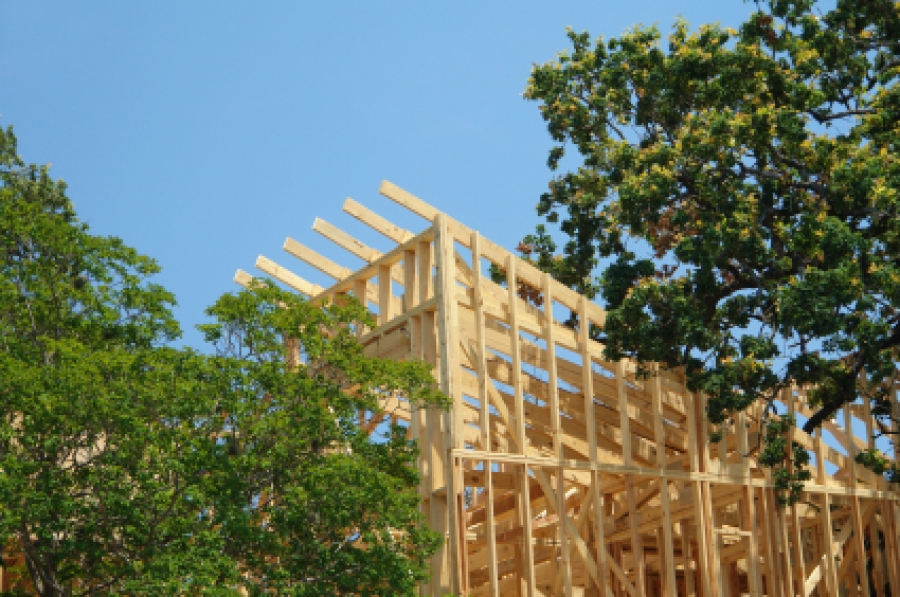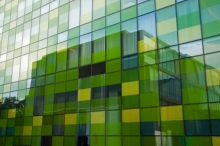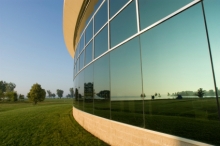Forecasting Green Construction Spending for 2011
Video
As LEED celebrates its 10th anniversary, the U.S. Green Building Council (USGBC) reports that one billion square feet of buildings around the world have now been LEED certified. Although that is just a drop in the global bucket, certification has helped to spur green construction; according to the Green Outlook 2011: Green Trends Driving Growth report by McGraw--Hill Construction (MHC), LEED specification is mentioned in 71% of all U.S. projects valued at over $50 million.

Green Outlook 2011 forecast that the U.S. green building market would reach $135 billion by 2015, up from $71 billion in 2010. A third of all new nonresidential construction is green, a $54 billion market opportunity. McGraw--Hill Construction predicts that in five years, major retrofit and renovation projects will total $18 billion. Green healthcare construction is expected to reach approximately 40% of this segment in 2011.
Riding on the tails of the green construction market, the market for green building materials also shows promise. This market will range from $5-$11 billion in 2011 (depending on who you talk to), with double-digit growth over the next few years. One forecast predicts the market for green building materials will reach over $30 billion by 2014.
Green flooring, which includes carpet, bamboo, and cork flooring, will become the market's fastest grower. The demand for Forest Stewardship Council (FSC)-certified wood panels is predicted to more than triple between 2008 and 2013, growing more than three times as fast as the overall market for wood panels. Other products expected to see double-digit growth through 2013 include water-efficient plumbing fixtures and fittings and energy-efficient lighting fixtures.
Benefits of Green Buildings
It is a no-brainer that green buildings have many benefits, including lower energy costs and water conservation. The Environmental Protection Agency (EPA) has found that green buildings with a recycling focus can reduce waste output by 90% and use 30% less energy, which equates to a 5% increase in net operating income.
In Green Outlook 2011, building owners cited three business benefits as the main drivers for building green. In addition to reduced operating costs of 13.6% on average for new buildings and 8.5% for retrofits, building values increased by 10.9% and 6.8%, respectively. In addition, return on investment increased by nearly 10% for new buildings and by almost double that for retrofits.
A 2009 study (”Do Green Buildings Make Dollars & Sense?”) of 154 green buildings totaling 51.6 million square feet in 10 U.S. markets found that green buildings have 3.5% lower vacancy rates and 13% higher rental rates.
Both rents and home values can rise by several percents or more. A recent study conducted by GreenWorks Realty in Portland and Seattle that compared environmentally certified home values to conventional home values showed that environmentally certified homes in Portland fetched 3-5% more, while environmentally certified homes in Seattle commanded up to 10% more. In 2010, environmentally certified office space was about $20 more per square foot than conventional office space.
Vacancy rates of green buildings are also often lower than conventional buildings. The CoStar Group found that the occupancy rate of LEED-certified buildings is 92%, versus the 87% occupancy rate of traditional buildings. Green buildings suffer fewer losses and are safer to insure because of the commissioning process required to become LEED-certified.
Government Is Key
It is obvious that the government -- whether local, state, or federal -- plays a critical role in the green construction market. According to McGraw--Hill Construction, as of September 2010, green building legislation and initiatives were present in 12 federal agencies and 33 states. The number of local government initiatives increased from 156 localities in 2008 to 384 localities in 2010.
Many states have a variety of programs that provide funding and tax incentives for green building. For instance, Maryland provides a tax credit for the construction of green buildings, which is worth up to 8% of the total cost of the building. Buildings must be located in a priority funding area and be at least 20,000 square feet. Massachusetts’ Renewable Energy Trust provides financial assistance to individuals, businesses, public entities, and communities for green building and renewable and clean energy projects.
In addition to federal loans and grants, the General Services Administration (GSA) tops government spending on green building. The GSA was approved a $675 million budget for 2011, an increase of $80.3 million from 2010. Of this total, $4 million is designated for GSA’s high-performance green buildings program and $20 million is designated to increase the energy and water efficiency of building systems. With the change in power after the mid-term elections, however, it remains to be seen how many of these incentives remain.
Turner Is Number One
There are a number of firms capitalizing on the growth in green construction. Turner Construction (New York, NY) is rated #1 of the Top 100 Green Contractors, according to Engineering News-Record. Following Turner’s lead is Tutor Perini Corp. (Sylmar, CA) at #2, with Clark Group (Bethesda, MD) at #3. In total, Tutor Perini has over 188 LEED-accredited staff and seven LEED NC registered projects under construction through its Rudolph and Sletten subsidiary. Clark has a number of certified LEED projects in the works, including Johns Hopkins Graduate Student Housing (Silver) and the Walter Reed National Military Medical Center (Gold).
Turner uses recycling on all its projects and all its field offices are green friendly. The company has 27 LEED APs in its Columbus office alone, 115 in Ohio, and approximately 1,200 nationwide. Turner has a total of 455 green projects nationwide costing $4 billion.
Turner's LEED projects in Ohio include the Huntington Center in Toledo (certified Gold), Idea Stream at Cleveland’s Playhouse Square, and Nationwide Children’s Hospital Research Building III in Columbus. The latter is scheduled for completion in 2012 at a cost of $93 million with a goal of improving energy performance by 24% over the ASHRAE standard.
Another Turner project, the OSU Medical Center expansion, is incorporating green roofing, an underwater collection system, air handling by zones, low VOC finishes, and sustainable flooring. Turner is also working on the $100-million Hilton Columbus project, with the goal of reducing both annual water consumption and energy costs by 30%.
Even Greener
The U.S. based Earth Advantage Institute has released a list of green building trends for North America in 2011. The top trends include energy labeling for homes and office buildings, building information modeling (BIM) software (about 50% of AIA architects currently use this software), buy-in to green buildings by the financial community, carbon calculation, and net zero buildings.
Geospatial technologies are also emerging as important new tools to inform and advance green building practice. Applications include advanced, “place-based” rating systems, building performance monitoring, and market patterns and trends dynamics. Some believe that information technologies, such as geographic information systems (GIS), will become new prerequisites for green building.
The future looks even greener over the next few years. USGBC predicts that 50% of nonresidential buildings in the U.S. will become green buildings by 2013, pumping $554 billion into the American economy and creating 7.9 million jobs. Even 75% of homeowners surveyed said that they are more likely to buy a green home over a traditional build.

Laurel Sheppard
Laurel M. Sheppard is an award-winning writer and editor who has authored several hundred articles related to ceramic materials technology and other engineering fields. She has a B.S. in ceramic engineering from Ohio State University and previously held editorial positions with Ceramic Industry, the American Ceramic Society Bulletin, Advanced Materials and Processes, and Materials Engineering. Her writing and editorial achievements have been recognized by the Society for Technical Communication, American Society of Business Press Editors, and Communications Concepts, Inc. She has also authored over a dozen market reports on various materials technologies and has written articles for IEEE’s Computer Graphics and Applications, Software Strategies, Native Peoples, SWE Magazine, and other publications.





